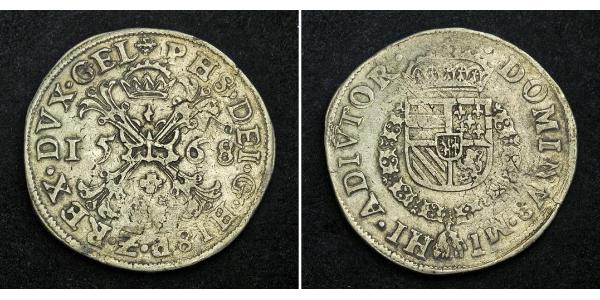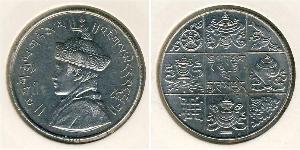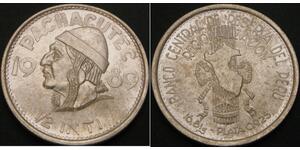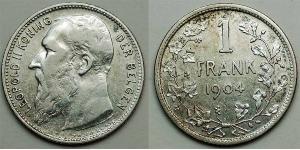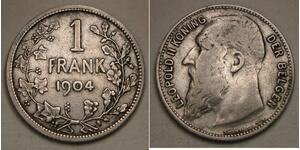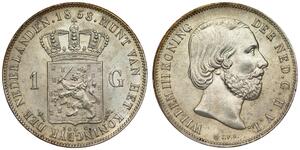(售价 $245.0)
1568, Spanish Netherlands, Philip II. Silver Rijksdaalder (Ecu de Bourgogne) Coin. R1!
Mint Year: 1563
Region: Gelderland
Mint Place: Nijmegen (mint mark: +)
Reference: Davenport 8497, Delmonte 92 (R1!). Rare!
Condition: Few scrapes in obverse, lightly cleaned, otherwise about VF/VF+!
Denomination: Burgundian Rijksdaalder / Ecu Bourgogne (French) / Bourgondische Rijksdaalder (Dutch) / Burgundischer Reichstaler (German)
Weight: 16.78gm
Diameter: 36mm
Material: Silver
Obverse: Crown above central fire-iron, from which cross-like sparks are forming St. Andrew's cross (symbol of Burgundy), splitting date (15-68) in fields. Mint mark (+) above.
Legend: + PHS . DEI . G . HISP . Z . REX . DVX . GEL / 15 - 68
Reverse: Crowned and quartered shield within collar of the Toison d'Or (Golden Fleece Order), which is splitting legend below.
Legend: DOMINVS · MI - HI · ADIVTOR + · ("The Lord is my aid!")
Nijmegen is a municipality and a city in the east of the Netherlands, near the German border. . During the Dutch Revolt, trade came to a halt and even though Nijmegen became a part of the Republic of United Provinces in 1585, it remained a border town and had to endure multiple sieges. In 1678 Nijmegen was host to the negotiations between the European powers that aimed to put an end to the constant warfare that had ravaged the continent for years. The result was the Treaty of Nijmegen that, unfortunately, failed to provide for a lasting peace.
Authenticity undonditionally guaranteed.
Philip II (Spanish: Felipe II de Habsburgo; Portuguese: Filipe I) (May 21, 1527 – September 13, 1598) was King of Spain from 1556 until 1598, King of Naples and Sicily from 1554 until 1598, king consort of England (as husband of Mary I) from 1554 to 1558, Lord of the Seventeen Provinces (holding various titles for the individual territories, such as Duke or Count) from 1556 until 1581, King of Portugal and the Algarves (as Philip I) from 1580 until 1598 and King of Chile from 1554 until 1556. He was born in Valladolid and was the only legitimate son of Holy Roman Emperor Charles V.
Under Philip II, Spain reached the peak of its power. Having nearly reconquered the rebellious Netherlands, Philip's unyielding attitude led to their loss, this time permanently, as his wars expanded in scope and complexity. So, in spite of the great and increasing quantities of gold and silver flowing into his coffers from the American mines, the riches of the Portuguese spice trade and the enthusiastic support of the Habsburg dominions for the Counter-Reformation, he would never succeed in suppressing Protestantism or defeating the Dutch rebellion. Early in his reign, the Dutch might have laid down their weapons if he had desisted in trying to suppress Protestantism, but his devotion to Catholicism and the principle of cuius regio, eius religio, as laid down by his father, would not permit him to do so. He was a devout Catholic and exhibited the typical 16th century disdain for religious heterodoxy.
One of the long-term consequences of his striving to enforce Catholic orthodoxy through an intensification of the Inquisition was the gradual smothering of Spain's intellectual life. Students were barred from studying elsewhere and books printed by Spaniards outside the kingdom were banned. Even a highly respected churchman like Archbishop Carranza, was jailed by the Inquisition for seventeen years for publishing ideas that seemed sympathetic in some degree to Protestant reformism. Such strict enforcement of orthodox belief was successful and Spain avoided the religiously inspired strife tearing apart other European dominions, but this came at a heavy price in the long run, as her great academic institutions were reduced to third rate status under Philip's successors.
However, Philip II's reign can hardly be characterized as a failure. He consolidated Spain's overseas empire, succeeded in massively increasing the importation of silver in the face of English, Dutch and French privateers, and ended the major threat posed to Europe by the Ottoman navy (though peripheral clashes would be ongoing). He succeeded in uniting Portugal and Spain through personal union. He dealt successfully with a crisis that could have led to the secession of Aragon. His efforts also contributed substantially to the success of the Catholic Counter-Reformation in checking the religious tide of Protestantism in Northern Europe.
The Philippines, a former Spanish colony, are named in his honor.
1 Franc 比利时 銀 利奥波德二世 (比利时)
本组有 15 钱币 / 14 售价
⇑
9 coin descriptions were improved from 2025-05-28 to 2025-06-04
其中一个是:
1 Gulden 荷兰王国 銀
本组有 5 钱币 / 5 售价

